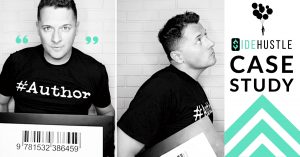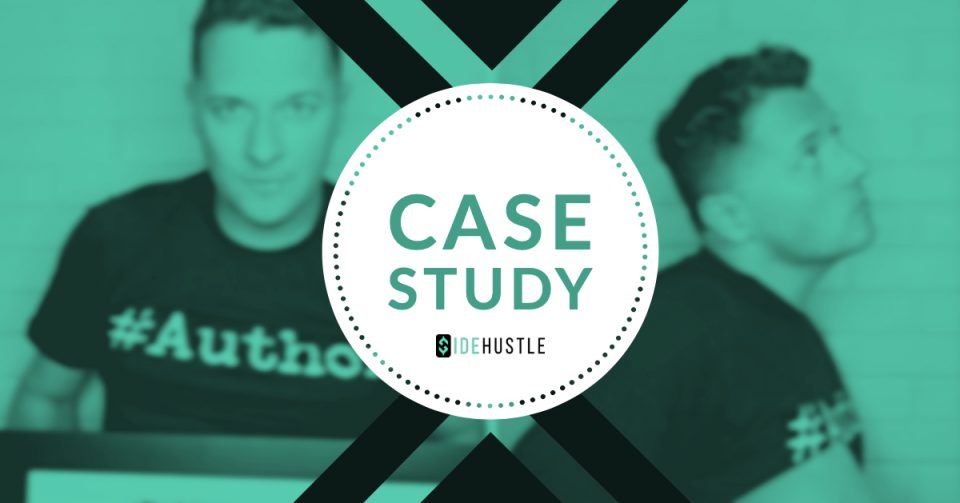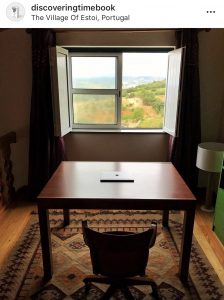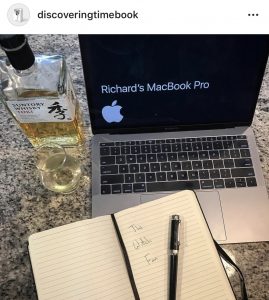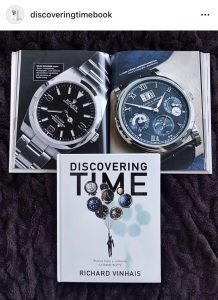Today’s Side Hustle case study explores a “new” author’s process in writing his very first book. Not only is he a dear friend of ours, he’s also one of our site’s co-founders (Richard Vinhais). He’s graciously offered up his time to be interviewed for this exclusive deep-dive into his journey to self publication. His book is called Discovering Time: Stories from a collector community
Introduction
The following words are more or less written in the interviewee’s voice, but with an editorial twist to keep things as concise and impactful as we could. Please enjoy our wide ranging conversation with Mr. UpperCrustLife himself, Richard Vinhais.
Megan Gless: Rich, I know your voyage to self publication was a rather lengthy process. How did you create your path to get to the finish line?
Rich Vinhais: Yeah, it definitely took what felt like a very long time. Overall, it was about a two year process filled with a ton of highs and lows. Honestly, I learned a lot as I went along. I had a pretty clear view of what I wanted to do, but the “how” wasn’t entirely clear to me at day one. My 10 steps to self publication is really more of a retroactive look-back at what I did after the fact to memorialize my journey.
Megan Gless: That’s right. You actually created a video that captured those 10 steps, but in a very abbreviated fashion. Can you share the “long form” version of those 10 steps now?
Rich Vinhais: Not sure how long form it’ll be, but let’s give it a shot.
Book Trailer Teaser
We’d like to open up by first sharing the behind the scenes making of the official book trailer. This is obviously some of the creative marketing that Rich put into the book. We thought it would be poetic to start with the ending in mind. It breathes some early excitement into what we think was a pretty awesome accomplishment. It’ll also also give you something to look forward to at the END of the article where we share the final 60 second trailer, which is an absolute must watch.
1. Establish a Clear Vision
Before I wrote a single sentence of the book, I began by thinking through a very simple thought experiment. It went something like this: “If I were to pick up a book on this exact topic today, what would actually attract me to it and make it enjoyable from start to finish?”
Synopsis
“Discovering Time: Stories from a collector community” takes readers on a humorous, unusual and illuminating look into the global subculture of watch collecting. It shares a series of themed short-stories, coupled with stunning photography, that breathes intimate perspective into a relatively clandestine and fiercely loyal community. At the heart of these stories, readers will be exposed to the phenomenon of “watch meet-ups” where complete strangers from all over the world gather to share their interest in timepieces, which often evolve into lifelong friendships. From local dive bars to exclusive exotic locations, socioeconomic barriers are cast aside and friendships forged, all in the mutual love of horology.”
With this compact summary, it did a few things for me early on. First, it helped crystallize my vision on paper and gave me some mental guard rails to operate within. Whenever I got lost in the minutia of the writing, I’d often revisit the synopsis to ensure I didn’t stray from the broader vision of what I was trying to accomplish. Second, it made the entire project feel more REAL. Honestly, it helped me visualize what the elevator pitch of the book would look like when it was eventually listed on Amazon, which was an empowering feeling all by itself.
Staying True
Although the synopsis above was preceded by a dozen or so prior versions, the core of the book’s scope never changed in any significant way. Sure, many of its details moved around along for creative reasons, but the fundamentals I started with over the two-year journey never changed. This was very much by design to ensure I wasn’t aiming at a moving target that was constantly strained with indecisiveness. Once the vision was set, there was no going back (even if I had doubts along the way, which I totally did) as I had to finish what I set out to do in the first place.
Note:
Below is a fun video Rich put together that explains his WHY. What would inspire him to take on the daunting task of writing a book? He talks about it here.
2. Game Plan
Without question the most difficult part of writing the book was freeing up enough time to do it justice. When I finally made the mental commitment that I was “going for it”, I then had to make sure I was on the same page with my wife. We spoke at length regarding what it would mean on the home front, especially with a child that was an infant at the time.
With my wife in full support, the rest was mainly sacrifice. I have a fairly demanding career, which entails a fair bit of time on the road. Even worse, my client schedule fluctuates a lot from one week to the next so establishing a repetitive writing routine was nearly impossible. I made the most of it by being ruthlessly disciplined with my time because I needed to be.
Making it Real
Every Sunday night I would look a week ahead to get a sense of what my work and life schedule looked like. I would think in terms of late nights, early mornings and weekends as my main windows of writing opportunity. I scheduled writing blocks into my calendar, which I stuck to like my life depended on it. Here’s what a normal writing week looked like:
Sample Schedule
- Monday: 5am – 7am
- Tuesday: 8pm – 12am
- Wednesday: 8pm – 12am
- Thursday: 5am – 7am
- Friday: Family Night
- Saturday: 6am – 12pm, Family Time, 9pm – 12am
- Sunday: 10am – 3pm
If I had a very busy work or family week, especially on the weekends (my most valuable block of time), then I’d embrace it as a “rest week” or accept that little to no writing would actually be done. That doesn’t mean I wasn’t constantly thinking about it though, which was probably the most important part of the process. Other times I’d embrace what I’d like to call a “marathon week”, which is when I had vacation time and/or coverage from my wife so I could focus. Those are the weeks I was able to put in double or triple my average writing time.
3. Find My Flow
Early on I attempted to experiment with a couple different writing styles until I found a voice that worked for me. I set out to make an entertaining book about a relatively unknown world of watch collecting, so I decided to keep things very conversational. To be honest, I also have a natural inclination towards a more playful writing style. I figured writing a book would be challenging enough, and didn’t want to add another layer of complexity by trying to be something I’m not. Once I found my version of an Anthony Bourdain-esque style, I leaned into it the best way I knew how.
Where to Write
One of the most unexpected obstacles I dealt with along the way was where I physically sat down to write. Interestingly enough, I learned early on that where I wrote had a pretty significant impact on my mood, which in turn played into my creativity. I constantly moved around if the inspiration didn’t strike after a while. My go-to spot was actually a private cigar lounge that had comfy couches and a cool vibe. It frequently got me going. Truth be told, I also did a lot of writing at Panera of all places. Something about the chaos of that establishment helped me focus on certain days, which was in stark contrast to the quiet cigar lounge I needed on others. I also wrote in planes, hotels, random coffee shops and of course my home.
Note:
Below is one of the coolest locations that Rich spent some time writing in, which was when he was on a family vacation in Portugal. A nice villa overlooking the countryside. How fitting is that for an author looking for inspiration?
4. Setting Stakes
It’s extremely easy to quit something you set out to do, especially if no-one knows about it. The fear of failure is a pretty intense emotion that can be used as an incredible source of motivation. I’ve used this tactic many times over the years by placing public accountability on myself. Whether it was for fundraising or training for a triathlon or marathon or trying to do something HARD, I try to avoid ever giving myself an easy way out.
Under Pressure
Once I KNEW I was all in on the project, I had to place added pressure on myself by letting people know what my plan was in different stages. First, I let my immediate family and close circle of friends know about my intentions. After I made some progress, I ratcheted up the pressure by sending out a broader public communication to a much larger network of friends to solicit their feedback and see if they wanted to be part of the journey in any way. From there, I made more and more public declarations on social media. This basically set in stone that I absolutely HAD to finish what I started or else feel the public shame from all those I asked to cheer me on to begin with.
Note:
Below is snapshot of one of Rich’s early email communications to a large group of friends. He used is as a tool to help keep himself accountability to his book journey.
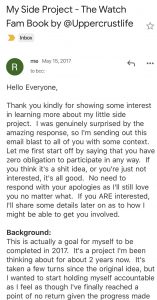
5. Stop Wishing Start Doing
Getting into a regular writing routine was very difficult for me, especially early on. I forced myself to write, good or bad, no matter what, as often as I possibly could. One thing I learned was that I couldn’t control when creativity struck! Just because I scheduled 6hrs to write on a Saturday morning doesn’t mean that’s how it played out. In fact, the physical act of writing was probably the easiest part. The bulk of my time was spent organizing my thoughts.
Once a concept clicked in my head, the rest really flowed. Of course, I did periodically hit mental blocks. To say they were frustrating would be a massive understatement. Whenever that happened, I tried to enjoy the process and remain positive. I just kept writing (even if I wasn’t in the mood) until things went from terrible, to decent, to good.
Pro Tip
Probably the MOST useful writing tip I picked up way too late in my journey was from Neil Gaiman. Neil, of course, is a prolific English author that also wrote one of my favorite books called The Graveyard Book.
His mental hack goes a little something like this. Whenever he sits down to write that’s literally all he’s allowed to do. He’s free to let his mind wonder to wherever it needs to go for as long as it needs to. He’s also allowed to do nothing at all. With those two acceptable actions in mind, he WILL NOT grant permission for anything else. In other words, he won’t allow himself to pick up a newspaper, flip on the TV, check out his instagram feed, etc. Ultimately, after a lot of random creative thought and/or nothingness, he’ll return back to his writing, which is by that point driven out of sheer boredom.
Let me tell you, this is a draconian discipline that really worked for me. I just wish I heard of this technique when I first started. For the bulk of writing journey, I really did experiment with just about every procrastination technique you could think of.
6. See the Forest for the Trees
One of the rules of thumb I consistently stuck to was to always see the forest for the trees. I regularly took several steps back from the fine details of my progress to reevaluate things. I was vigilant about making sure everything tied back to the broader experience I wanted people to feel. Of course, the book needed to be authentic, but most importantly it needed to be fun. If it wasn’t fun enough, I’d make adjustments. If it wasn’t balanced enough with useful contextual information, I also made changes. So on and so forth. These were critical moments used to shape the broader experience and ensure the overarching narrative of the book shined through.
Thinking Big
At its core, Discovering Time was always intended to be comprised of a collection of short-stories, but the number of them and their flow was not known in advance. I was constantly modifying their sequence along the way to find the best and most enjoyable balance of emotions. Each story carried a very wide range of them. In the end, I just used a lot of personal intuition in determining when I thought I was actually DONE.
Once I had a strong collection of stories in place, I quickly realized the entire book was not well rounded enough. It just felt flat. I never would have noticed that had I not taken a step back to reflect on how the finished product might actually be perceived. So, I went on to expand the early introductory chapters to better set up the short stories themselves, which worked out great. From there, I wrote additional chapters that followed the short stories to tie up loose ends and add more color to the world I was describing. These changes led to creating a more natural flow with a stronger beginning, middle and end that would create a far richer reading experience.
Pro Tip
One technique I often used was the usage of colored sticky notes, especially when it came to organizing the sequencing of short stories or figuring out the flow of an idea. The visual representation helped things click in my head at a much higher level. It was also super easy to just physically move sticky notes around to foster some creative problem solving. For some strange reason, they frequently helped get my creative juices flowing on a fairly regular basis.
Note:
Below is a great image that illustrates Rich’s “sticky note” technique in action.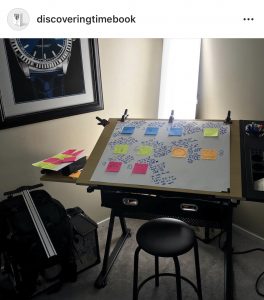
7. Wax, Polish and Repeat
Once I finished writing the book, I made a point to clean it up as much as I could. Looking back, I took a three step process to refining it:
3 Magical Steps
- For Myself: In my first pass, I 100% wrote and edited for myself. At a minimum, I needed to love what I wrote even if no-one else did. I stayed true to what I wanted to do creatively. I always accepted suggestions from others, but did not allow them to alter the big picture of what I set out to do.
- For the Masses: In my second pass, I did so for the masses. In this pass I tried to put myself into the shoes of people that probably knew nothing about the topic, and creatively found ways to make sure the content would resonate well beyond the people that were already immersed in.
- For the Haters: In my the third and final pass I made it all about preparing for the inevitable haters. This was all about making sure I had no silly factual errors anywhere and the authenticity of what I set out to do really rang true.
I’m sure there may be tons of other ways to think through this process, but this one felt most logical to me at the time. It was a great way to force me to trim the fat wherever I could. In this step, I honestly took the book as far as I possibly could have by myself.
Note:
Although not entirely relevant to this particular step this a great interview with Rich. In it he gets into his WHY a bit more, but it also dives into a whole lot more. The perspective really sheds light on the journey through the lens of his stories. It’s pretty inspiring stuff.
8. Battle with My Wife (also my editor)
Seeing that I was self-publishing, I didn’t have a fancy publisher to guide me through the editorial process. I had to rely exclusively on friends and family. My wife is a brilliant writer, and was kind enough to lend an extremely generous amount of time. She had always been supportive of my goal to write a book, but watching her play the “tough editor” role was a hard pill to swallow. I still vividly remember her first round of proposed changes. The red ink. The sticky notes. It hurt. It hurt deeply and made me question everything I had written up to that point. She kept it surprisingly clinical like a seasoned pro would. Ultimately, she made me grow, which in turn made the finished product a lot better than I ever would have on my own.
A Family Affair
In addition to my wife, I also had the support of my dear friend Megan Gless (author of this article) and my sister, Sandy Nielsen. Both played the role of fact checkers to ensure the quality was where it needed to be. They also each read the book cover to cover, and offered up constructive suggestions to fine-tune. Not to mention flagged any and all potential mistakes that seemed off to them. It was truly a humbling experience watching them care as much as they did for my little passion project. Honestly, it was heartwarming and ‘ll forever be grateful for their support.
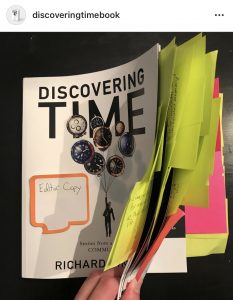
9. Design Something Beautiful
I knew I wanted to make a book that was full of substance. In addition to that, I wanted it to look incredible on a coffee table. I had a very specific vision of how I wanted the book to feel. I just needed a lot of help to pull it off. Many people from the watch community contributed their own photography to the book, which made it that much more authentic.
In addition to the contributors, I also played a photographer role and took quite a few pictures myself. Many photos were of my own personal watches. Several of them belonged to friends that wanted to be part of the book. They just didn’t have the camera gear to contribute, so I just did it for them. Having the image assets was great, but would need a lot more help to bring it all together digitally. All told, I interviewed over a hundred freelance designers. I ended up using about a half a dozen folks.
My Design Crew
In terms of the most critical contributors, it came down to only a handful of them. The art direction for the book cover itself came from my cousin, Shawn DoSantos. He’s a world class creative that really helped me shape a design, which took place over weeks of brainstorming. The goal was to create something minimalist that would also be very playful and unique. Once we landed on the concept, I then hired an illustrator. After a few dozen iterations we landed on our final cover design.
The body of the book itself was digitally formatted, with my explicit direction, by Justin Oefelein. He did a great job keeping pace with putting together the layout exactly how I wanted. Just before going to print, I picked up some last minute help. My dear friend Mike Pinto went through FINAL digital enhancements to ensure everything was properly optimized for hard copy printing. This made sure everything was completely ready before handing things over to my print partner.
Printing is Tough
At its core, book printing is a very straight forward process. It’s especially simple when you’re dealing with a paperback that’s black and white. It’s easy to format with basic settings, cheap to print and cheap to ship. The polar opposite was true for my book. It’s hard cover and over-sized (in turn very heavy). In addition, every page is in high gloss color with creative formatting and high resolution imagery.
Finding a print partner took months of pain-staking research, quote collections and conversations. I initially tried to find a US-based print partner, but quickly learned that pricing was economically impossible. That forced me to look overseas and specifically to China. Let me tell you, it’s a pretty stressful experience cutting a massive deposit check. It’s especially stressful when you’re not 100% sure how things are going to work out. What if they decided to hose me? I’d literally have zero recourse to get my money back, which messed with my head a bit at the time. Obviously it all worked out. Overall, I was extremely pleased with the finished product.
Amazon: A Necessary Evil
Once printing was done, I had a crate of cases sent to my home and the rest, which was the vast majority, sent to an Amazon distribution center. With my Amazon Seller account (costs about $40 per month plus a slew of other fees), I configured the details of my book and set a launch date. The service was pretty straight forward, but I must admit I did run into a bunch of irritating technical issues. One major issue was that users could NOT search for the book through their Amazon search bar. That lasted for the first couple weeks of launch, which was obviously unacceptable. That required me to submit dozens of help desk tickets until things were eventually sorted out. Once all the kinks were worked out, the service ran and continues to run about as well as you’d expect. Plus, who doesn’t love Prime shipping?
10. Face my Fears
Once I was happy with the finished product, it was time to put myself out there. I was extremely proud (still am) of what I had put together, but i’d be lying if I said I wasn’t afraid of how people would respond to it. To build some hype, I threw a fun pre-launch party in NYC. Friends, family and locals came out in droves to support. It was a humbling experience, especially when a long lined formed to meet me and collect a signed copy. That evening with remain one of the most memorable nights of my life. I truly was a special experience to commemorate a noteworthy achievement.
Fueling the Hype-Train
On the heels of the event, I attempted to build some social media hype more aggressively. It was important that people knew that the official launch date was imminent. Less than two weeks later, the book was available on Amazon. I rallied all my amazing Instagram friends to share the news, which was remarkably effective to gain broader attention. Friends and family also did their part. Simultaneously, I released an official book trailer to add to the hype train. The goal was to pique broader interest beyond all my watch-nerd friends. In general, it was all extremely well received.
Regrets
Looking back, there are a number of little things I could have done differently and certainly better, but I have no regrets. One major change I probably would have done, if I were to do it over again, would be to hire a publicist. After the initial barrage of sales activity, which coincided with the holiday season, I had zero free time to really push the book in any sustained way. I still don’t. Had I hired a publicist, even for a few months, they could have delivered far more bang for the buck vs. me trying to poorly figure it out on my own.
Goals
My goals for the book were simple. Create something I can be proud of. I feel like I accomplished that, and i’m extremely thankful that its resonated with as many people as it has. My book reviews seem to demonstrate that in general. I love them. In fact, many of them directly reflect the exact emotions I was hoping they would inspire for readers.
Expectations
I had low-expectations in terms of how well the book would sell, especially given its niche focus. That just wasn’t a priority me. Of course I wanted to break-even, but I was also mentally prepared for a financial lose. Thankfully, the book has done very well and I’ve managed to turn a modest profit. The greatest benefit, that I didn’t anticipate from this journey, is being able to pridefully say that I’m an author. Looking back, I almost can’t believe I pulled this off. That’s something that can never be taken away from me.
Note:
As mentioned, here is the official book trailer for Discovering Time: Stories from a collector community
Book Trailer
Closing Thoughts
Megan Gless: Rich, thank you for taking the time.
Rich Vinhais: My pleasure, Megan. That was a wild trip down memory lane. I’ve not thought about the journey in such a low level of detail before. I enjoyed it.
Megan Gless: I’m glad. Any plans for a follow up book?
Rich Vinhais: Highly unlikely with a strong slant towards NO. Only thing I got brewing at the moment is creating an audio book version of Discovering Time, which is nearly complete.
Megan Gless: How has that process gone?
Rich Vinhais: It’s been painful and taking way longer than I thought it would. It’ll be ready when I’m happy with it. I’m learning as I go.
Megan Gless: Just like the book?
Rich Vinhais: Exactly like the book!
Final Note:
We thought it would be appropriate to embed Rich’s “Writing a Book in 10 Steps (Casey Neistat Style)” video because #1) It’s very much on topic here as it’s basically a video format of what you’ve just read and #2) It’s pretty bad-ass, well done and super entertaining. As you watch it, how many watches can you spot?
